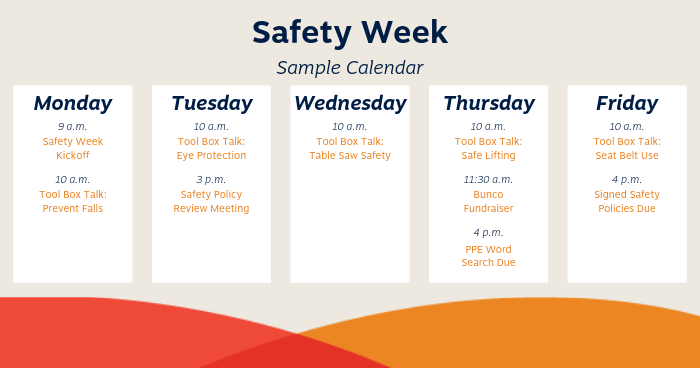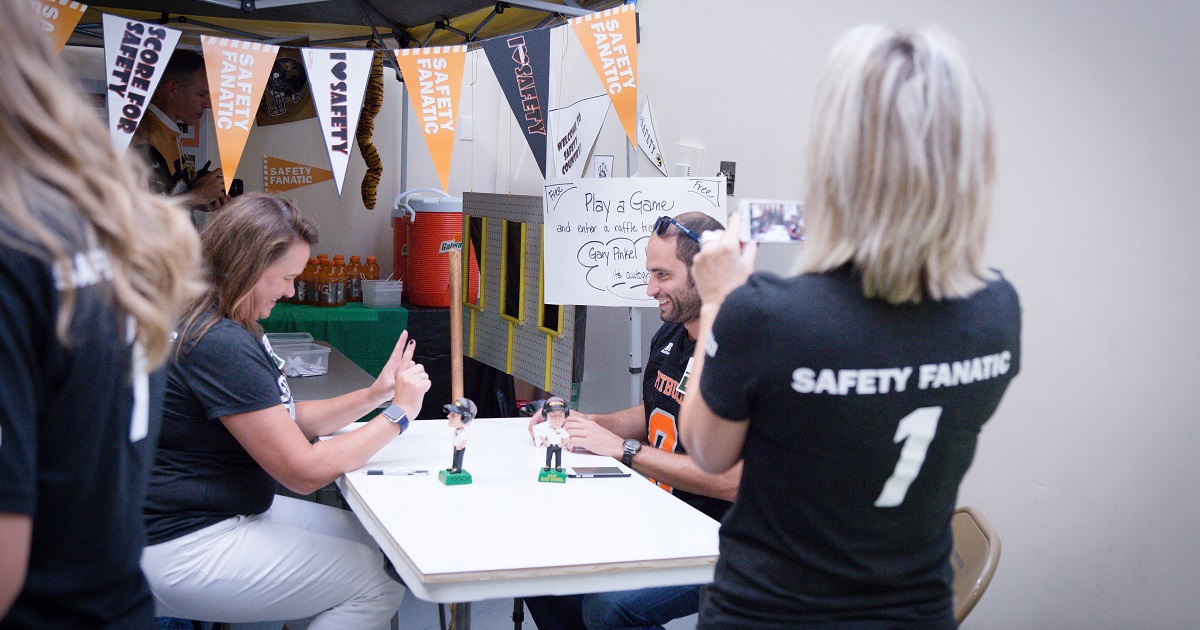For Media Inquiries
Contact Revee White, Director of Marketing and Communications at rwhite1@mem-ins.com or 573.499.4190.
At Missouri Employers Mutual, safety is on our minds every day – and we hope it is at your company, too! Once a year, our Safety Fanatics dedicate a “safety week” to learning about and improving workplace safety. We call it WorkSAFE Week, and we invite you to host your own.
Here’s what you’ll need to start planning.
What is Safety Week?
Safety Week is a dedicated week set aside during the year for your employees to learn more about safety, re-sign workplace safety policies, and have some fun! Each day, a little time is dedicated to sitting down with employees and learning more about how to work safely. Safety weeks will look different depending on your industry and what your employees need to know more about.
Any workplace can benefit from a Safety Week! Workplace injuries can happen when employers and their employees get complacent about safety measures. Every employee can learn something during a Safety Week, whether it’s how to safely use hazardous workplace equipment or wipe up spills in the company kitchen.
WorkSAFE Week at Missouri Employers Mutual
At MEM, we have been hosting WorkSAFE Week for the past five years. Want to learn more about how we do it? Join Tisha Greco and Caitlin Way for a podcast all about planning! They are members of our Safety Fanatics Committee, an in-house group that strives to create more safety experts every year. Safety awareness shouldn’t happen just once a year – employees should be constantly refreshed on the best ways to protect themselves and others. Learn more about how our Safety Fanatics Committee shares safety all year long by listening below.
What’s the purpose of Safety Week?
Around 4.5 million injuries happen at work every year. The top causes of injury don’t change – year after year, they are:
- Overexertion
- Harmful contact with equipment
- Slips, trips and falls
When it comes to on-the-job fatalities, you can add motor vehicle accidents to that list, too. If we could address just these four common causes of injury, we could hugely impact the number of people who go home safely at the end of each day.
The purpose of Safety Week is to take a step back and focus on safety at your workplace. Safety isn’t rocket science, but a successful safety program does require dedication and resources.
By spending a week every year intensely focused on safety, you’re showing your employees that you care about them by giving them the knowledge and tools they need to work safely every day. Plus, it’s a great opportunity to get your safety policies and procedures in front of all the new employees you’ve hired in the past year.
> Resources for contextualizing Safety Week:
- Foundations of a Workplace Safety Program [article]
- Watch List: Top Causes of Workplace Injuries in 2018 [article]
- New Hire Safety Training Tips for High-Risk Industries [podcast]
Where to start
Every business is different. We all face different risks and safety challenges. Tailor your Safety Week to your company. Do as much – or as little – as you want. Start by asking yourself a few questions:
- What are the most common injuries at my company? In my industry?
- Have I noticed any problem behaviors or safety-related trends at my company?
- If I had a magic wand, all our employees would follow these three safety rules…
- Do my employees face any barriers to complying with safety policies? How can I address those?
- What feedback do I need from employees about our safety policies and procedures?
Answering these questions will help you identify the highest priority topics or policies. Don’t forget to get others involved. Share your plan and seek help with hosting. When you’ve identified your most important opportunities to make an impact with Safety Week, it’s time to work on the details.
Communication and promotion
Leave yourself plenty of time to communicate with your employees about upcoming Safety Week activities. Communicate early and often about the purpose and how employees can get involved. Some communication ideas:
- Create an activity calendar and hang it in break rooms or common areas
- Send an email outlining all activities one week before Safety Week
- Send calendar invitations to all employees for big events like the kickoff
Of course, prioritizing safety is also great for your company’s reputation! Share the news with your community by sending a press release to your local paper or media outlet.
Add some fun for employees
You can better engage employees by adding a little fun to your Safety Week! Choosing a theme – such as a carnival, tailgate, or game show – can help employees get into the spirit. Share safety information in common areas and decorate them to match your theme. For employees with a competitive edge, create small employee teams and take time to play a few games.
> Communication and promotion resources:
- Canva: Design a Calendar [website]
- Safety Week Press Release [template]

4 Sample Safety Week activities
Here are a few activity ideas for your Safety Week. They don’t take much time – the purpose isn’t to stop all operations for a week for safety training. Rather, you can build these into your day by spending 10 minutes here and there.
1. Hold a kickoff meeting
Time: 20 minutes
Consider starting Safety Week with a kickoff on Monday morning. Gather all employees and have a member of your leadership team explain the purpose of the week. Give an overview of the week’s activities and opportunities for employees to participate.
When discussing the purpose of the activities, consider adding meaning where appropriate. Workplace injuries can be devastating, and they are preventable! You could share some compelling statistics from the Department of Labor, your own company’s injury rate or even safety success stories.
At MEM, we read aloud the names of our policyholders’ employees who were killed on the job in the past year. It’s a sobering reminder that there is always more we can do to improve safety.
> Resources for your talking points:
- Bureau of Labor Statistics: Injuries, Illnesses and Fatalities [website]
- MEM Policyholder Success Stories [articles]
2. Conduct Tool Box Talks
Time: 5-10 minutes per day
Spend a few minutes each day of Safety Week on a different topic relevant to your company and industry. We have nearly 50 pre-made Tool Box Talks that you can use, or you can create your own by choosing a topic and outlining a few key points for your employees.
Don’t have 10 minutes a day to gather all your employees? Re-envision your Tool Box Talk information into a game. For example, you could reward employees for completing a word search containing the names of the PPE they’re required to wear on the job site.
> Tool Box Talks and other resources:
- Slip Prevention [Tool Box Talk]
- Trip Prevention [Tool Box Talk]
- Safe Lifting Techniques [Tool Box Talk]
- All Tool Box Talks [resources]
- Five Safe Driving Best Practices for Your Employees [article]
- The Teacher’s Corner: Create a Word Search [website]
3. Review safety policies
Safety Week is a great time to revisit your safety policies with employees. Charge every supervisor to cover your policies with their team during the week, addressing common concerns and answering questions. You can also have employees acknowledge the policies with a signature every year. Keeping your safety policies top of mind is the best way to encourage employees to follow them!
Need help refreshing your policies before Safety Week? Policyholders can contact our Resource and Support Center.
> Sample policies:
- Seat Belt Usage Policy
- Alcohol and Substance Use Policy
- Cell Phone and Driving Policy
- Accident Reporting Policy
- All sample policies [resources]
4. Display resources in the workplace
In our resource library, you’ll also find posters and infographics. Hang these up in your facilities during Safety Week to visually reinforce the safety information you’re providing throughout the week.
> Resources to print and display:
- 6 Secrets of Injury-Free Workplaces [infographic]
- Drug-free workplace [poster]
- Distracted driving [poster]
- Prevent slips and trips [poster]
For more information to use during Safety Week, policyholders can request DVDs from our Resource Library.
Fundraising activities
If you have a very engaged workforce or community involvement program, you might consider incorporating fundraising into your Safety Week plan. At MEM, we raise money for Kids’ Chance, a nonprofit that supports the education of children of workers killed or seriously injured on the job.
Fundraising is totally optional, but it can add a fun and/or competitive element to your Safety Week. Employees – including company leadership – will often buy into a Safety Week even more when it benefits the community. Most of these activities can be done over lunch or on employees’ own time, so they don’t eat into your productivity.
Some activity ideas:
- Bake sale or dessert auction: Ask employees to bake and donate
- Bunco, Bingo or group card games: Charge an entry fee and split the pot – half to the winner, and half to the nonprofit
- Silent auction: Ask local businesses to donate items
- Big wheel races: Pit your leadership team against each other and take bets on the winner
- Food trucks: Ask local trucks to come to your parking lot over lunch, donating a portion of proceeds to the nonprofit
- 5K: Charge an entry fee and give small gifts like water bottles or post-run snacks
> Websites for planning fundraising activities:
- Kids’ Chance [website]
- Bunco Fundraisers [website]
- 52 Fundraising Ideas that Your Office has to Try Out [website]
